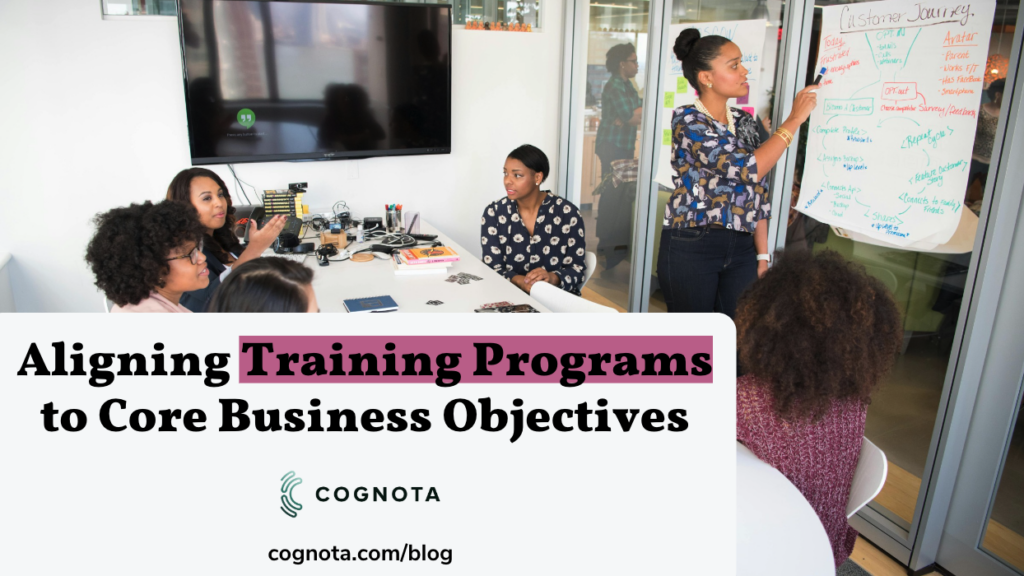In today’s fast-paced and competitive business environment, the role of Learning and Development (L&D) teams has never been more critical. One of the key responsibilities of these teams is to ensure that training programs are aligned with the overarching objectives of the organization. This alignment is not merely a matter of convenience; it is a strategic imperative.
Business objectives serve as the guiding light for an organization, defining its purpose, direction, and measures of success. Therefore, it’s essential for L&D professionals to carefully align their training initiatives with these objectives to ensure their relevance and effectiveness. When training programs are strategically aligned with business goals, they become powerful tools for driving organizational success and competitiveness.
Cognota is the only L&D software provider to partner with the ROI Institute to integrate their evidence-based ROI Methodology®, so you can assess learning program effectiveness and business impact, ensuring a tangible return on learning investments with a tested, proven methodology. We’ll chat more about this too!

To effectively align training programs with business objectives, it’s essential to first have a clear understanding of what those objectives entail. Business objectives encompass both short-term and long-term goals that guide the organization’s strategic direction. Short-term goals may include increasing sales targets, improving customer satisfaction, or enhancing operational efficiency, while long-term goals could focus on market expansion, innovation, or sustainability initiatives.
Central to understanding business objectives is the identification of key performance indicators (KPIs). These metrics serve as tangible measures of success, providing benchmarks against which progress can be evaluated. By identifying and aligning training initiatives with these KPIs, L&D professionals can ensure that their programs directly contribute to the achievement of broader organizational goals. Additionally, establishing alignment between training goals and business objectives involves mapping out specific training outcomes that directly support the priorities of the organization. This process requires a nuanced understanding of the organization’s strategic direction, as well as ongoing communication and collaboration with key stakeholders to ensure alignment at every level of the organization’s hierarchy.
Aligning training programs to business objectives requires a strategic approach that begins with conducting a comprehensive needs analysis. This involves identifying skill gaps within the workforce and assessing current capabilities to determine where training interventions are needed most. By understanding the specific competencies and knowledge areas required to support the organization’s objectives, L&D teams can tailor training content and delivery methods to address these areas effectively. Whether through workshops, e-learning modules, or on-the-job training, customization ensures that training programs are directly relevant to the skills and knowledge employees need to contribute to the achievement of business goals.
Furthermore, incorporating feedback loops into the design and implementation of training programs is essential for maintaining alignment with evolving business objectives. Continuous evaluation and refinement allow L&D teams to adapt training initiatives in response to changing organizational priorities and market dynamics. Soliciting feedback from participants and managers provides valuable insights into the effectiveness of training interventions, enabling adjustments to be made as needed to ensure ongoing alignment. By iteratively improving training programs based on feedback and results, organizations can ensure that their L&D efforts remain closely aligned with the strategic direction of the business, maximizing the impact of training investments on overall performance and success.

Evaluating the success of training programs and their alignment with business objectives is crucial for measuring the impact of L&D initiatives. This evaluation involves monitoring key performance indicators (KPIs) to track the progress and effectiveness of training interventions. Metrics such as employee performance improvements, productivity gains, and customer satisfaction ratings can provide quantitative measures of success, indicating whether training programs have contributed to the achievement of business goals.
Additionally, soliciting feedback from participants and stakeholders through surveys, interviews, and performance reviews offers qualitative insights into the perceived value and impact of training initiatives. By analyzing both quantitative data and qualitative feedback, organizations can assess the extent to which training programs have met business objectives and identify areas for further improvement or refinement. Ultimately, a comprehensive evaluation process ensures that L&D efforts remain closely aligned with organizational priorities, driving continuous improvement and maximizing the return on investment in training initiatives.

In partnership with the ROI Institute, Cognota has released our Program Strategy Module. Using these features, teams can:
- Add Learning Programs and associate related projects.
- Apply Reaction Objectives — Your learners’ experience is important. Engaged and satisfied learners are the foundation for a successful program. What reactions does this program need to elicit?
- Apply Learning Objectives — What new skills and/or competencies should learners gain from this program?
- Apply Application Objectives — “Application” refers to how the knowledge and skills gained through this learning program should be applied. What behavior changes should this program influence?
- Effortlessly manage and track the results of these objectives.


Let us know if you have any questions about this exciting new feature set, or share how your team is aligning your programs back to the business at learnops.com.





